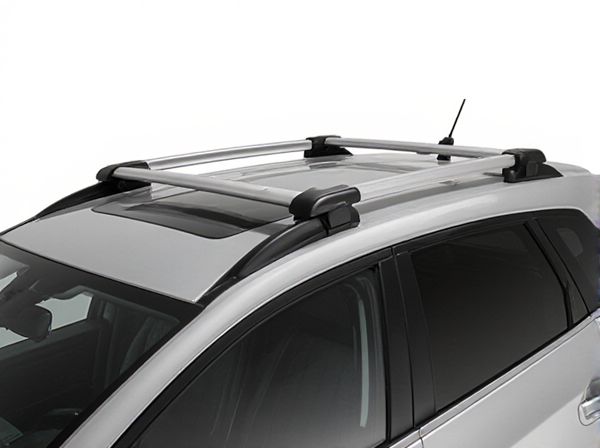
Photo illustration: Flush Roof Rails vs Raised Roof Rails
Flush roof rails offer a sleek, integrated look that sits close to the vehicle's roof, enhancing aerodynamics and reducing wind noise. Raised roof rails stand above the roofline, providing greater clearance and versatile attachment points for cargo carriers, making them ideal for heavy-duty hauling. Your choice depends on whether you prioritize style and airflow or maximum utility and load capacity.
Table of Comparison
| Feature | Flush Roof Rails | Raised Roof Rails |
|---|---|---|
| Design | Sleek, integrated with roof surface | Elevated, stands above roof line |
| Aerodynamics | Better airflow, reduced wind noise | More wind resistance, increased noise |
| Load Capacity | Moderate, suitable for light cargo | Higher, supports heavy loads |
| Installation | Often factory-installed, less visible | Can be aftermarket, easier mounting |
| Maintenance | Low dirt accumulation, easy cleaning | Prone to debris buildup, requires regular checks |
| Compatibility | Fits modern vehicle designs | Works with various car models and roof accessories |
Introduction to Roof Rails: Flush vs Raised
Flush roof rails sit nearly flush with the vehicle's roofline, offering sleek aerodynamics and a streamlined appearance while maintaining low drag. Raised roof rails extend above the roof surface, providing additional space to easily attach roof racks, cargo boxes, or other accessories for versatile cargo carrying. Choosing between flush and raised roof rails depends on balancing aesthetics, aerodynamic efficiency, and cargo capacity requirements.
Design and Construction Differences
Flush roof rails integrate seamlessly into the vehicle's roofline, offering a sleek, aerodynamic design that reduces wind noise and drag. Raised roof rails extend above the roof surface, providing increased clearance for mounting cargo carriers and other accessories but potentially affecting fuel efficiency. Construction-wise, flush rails are often molded into the roof structure or attached closely for a low-profile appearance, whereas raised rails are mounted with brackets, elevating them for enhanced functionality and load capacity.
Visual Appearance and Aesthetics
Flush roof rails integrate seamlessly with the vehicle's roofline, creating a sleek, aerodynamic profile that enhances visual appeal and modern aesthetics. Raised roof rails, sitting above the roof surface, offer a rugged, utilitarian look that emphasizes functionality but may disrupt the vehicle's streamlined design. The choice between flush and raised roof rails significantly influences the vehicle's overall style, with flush rails favored for a minimalist, sophisticated appearance and raised rails preferred for a bold, adventure-ready stance.
Installation and Compatibility
Flush roof rails offer a sleek, integrated design that typically requires less time to install, as they align closely with the vehicle's roof and use existing mounting points. Raised roof rails stand above the roof surface, often necessitating drilling or additional brackets for secure attachment, making installation more involved but compatible with a wider range of accessories. Compatibility-wise, flush rails suit modern vehicles with aerodynamic styling, while raised rails accommodate off-road gear and larger cargo systems, providing versatility for various roof rack applications.
Roof Rack and Accessory Attachment
Flush roof rails provide a sleek, low-profile design that aligns closely with the vehicle roof, reducing wind resistance and noise while offering integrated mounting points for roof racks and accessories. Raised roof rails stand above the roofline, allowing easier attachment of crossbars and accessories without the need for specialized mounting hardware, supporting versatile roof rack configurations. Both styles support secure roof rack installation, but raised rails may offer improved accessibility for heavier or bulkier items due to their elevated clearance.
Aerodynamics and Fuel Efficiency
Flush roof rails offer a sleek design that minimizes air resistance, enhancing aerodynamics and improving fuel efficiency by reducing drag on the vehicle. Raised roof rails, while providing greater cargo capacity and ease of use for attaching accessories, create additional wind resistance, leading to increased aerodynamic drag and thus slightly lower fuel economy. Choosing flush roof rails is ideal for drivers prioritizing fuel savings and reduced wind noise during highway travel.
Noise Levels During Driving
Flush roof rails offer a sleek design that minimizes wind resistance and significantly reduces noise levels during driving compared to raised roof rails. Raised roof rails tend to create more turbulence, generating higher wind noise, especially at highway speeds. Choosing flush rails enhances cabin quietness by promoting smoother airflow over the vehicle's roof.
Load Capacity and Strength
Flush roof rails offer a sleek design integrated closely with the vehicle's roof, providing moderate load capacity typically around 75-100 pounds, suitable for light cargo. Raised roof rails stand above the roofline, delivering higher load capacity--often exceeding 150 pounds--due to enhanced structural support and easier attachment points for heavy or bulky gear. The increased strength of raised rails makes them preferable for carrying roof racks, cargo boxes, and heavy-duty equipment on SUVs and trucks.
Suitability for Different Vehicle Types
Flush roof rails offer a sleek, integrated design ideal for modern SUVs and crossovers, enhancing aerodynamics and minimizing wind noise, which suits daily urban driving and light cargo needs. Raised roof rails provide versatility and higher load capacity, making them better suited for larger SUVs, trucks, and off-road vehicles that require robust support for heavy gear and roof racks. Choosing between flush and raised roof rails depends on vehicle type and intended use, balancing aesthetics with functionality for optimal performance.
Which Roof Rail Type Should You Choose?
Flush roof rails offer a sleek, low-profile design that enhances vehicle aerodynamics and aesthetics, making them ideal for those prioritizing style and fuel efficiency. Raised roof rails provide superior versatility and easier attachment points for racks or cargo carriers, perfect for individuals who frequently transport gear or luggage. Choose flush roof rails for streamlined appearance and better gas mileage, or opt for raised roof rails if functionality and cargo capacity are your primary concerns.
 caratoz.com
caratoz.com